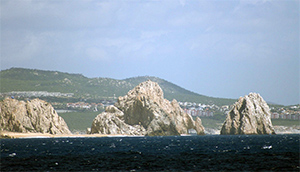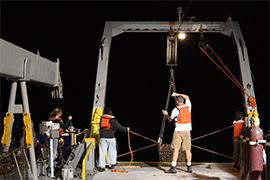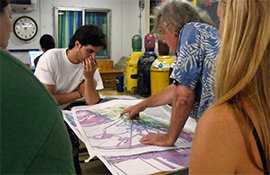|
Tracking the Birth of an Ocean
Scripps geologists provide daily accounts of life at sea as they journey to the
Gulf of California to collect rock sample, in areas never studied before
By Annie Reisewitz | Oct. 12, 2009

Rocks protruding out of the seafloor near Cabo San Lucas.
A team of scientists at UCSD’s Scripps Institution of Oceanography is deftly dredging up pieces of the Gulf of California seafloor in search of a more detailed view of the new ocean floor that is emerging.
On Oct. 5, three days after the GEOFORM2009 research team set off aboard research vessel New Horizon from Scripps’ Nimitz Marine Facility in Point Loma, the scientists encountered a mega-pockmarked field, filled with giant holes formed along the seafloor.
“These pockmarks are huge—over a kilometer across in some cases and hundreds of meters deep,” the researchers said in their blog, GEOFORM2009. GEOFORM2009 stands for the Geological Exploration of the Formation of a Rifted Margin.
By studying the unusual geological features along the Baja California peninsula, the team of scientists from the U.S. and Mexico and led by Scripps graduate student Jared Kluesner, hopes to shed new light on the formation of the Gulf and the transition from a continent that is splitting apart by the birth of an ocean.

Deploying dredge.
Over the past 12 million years, Baja has been slowly rifting apart – pulling itself away from mainland Mexico – resulting in the thinning of continental crust and eventual transition into young oceanic crust.
To gain insight into the region’s geologic history, Kluesner will use sound waves in conjunction with the information obtained from the rock dredges to create a detailed image of the geological structures below the seafloor. This research study will enable the science team to better understand the current geological processes taking place in the narrow strip of water that forms the Gulf of California.
During the 10-day research expedition, the scientists will be collecting rock samples from fault scarps and underwater mountains using a one-meter wide rock dredge and imaging unusual geological features with a sub-bottom CHIRP profiler to see deeper into the rock structures.
Nearby, the pockmark field was the team’s next target—a steep seamount rising up out of the surrounding sediments, the scientists recounted in their daily blog. The metal dredge was lowered to a depth of 1,300 meters (4,265 feet) to scoop up rocks from a large submerged mountain.

Scripps professor Dr. Peter Lonsdale teaches students about local geology.
“These rocks look completely different from the ones we found yesterday, but they are encrusted, so it will be important to split them before we can identify them further,” said the scientists.
As the ship steams toward the Gulf of California, the research team will be sawing open the newly acquired, basketball-size rocks as they heave them onboard, in order to get a closer look at how the once-submerged continent is slowly transforming into new seafloor.
Sign up to read more on the Scripps-led GEOFORM2009 expedition in the November/December issue of explorations, Scripps’ free e-magazine, at explorations.ucsd.edu.

|